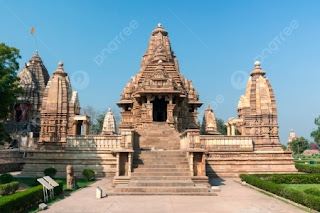Rajput architecture in India stands as a testament to the artistic brilliance and grandeur of the Rajput rulers who left behind a legacy of magnificent palaces, forts, temples, and havelis. Influenced by a blend of Hindu, Islamic, and indigenous architectural styles, Rajput architecture showcases a unique aesthetic that continues to captivate visitors from around the world.
The origins of Rajput architecture
can be traced back to the 8th century when the Rajput kingdoms emerged in
various regions of present-day India. The Rajputs, known for their valor and
chivalry, also displayed a keen interest in promoting art and architecture.
Over the centuries, Rajput architecture evolved under the patronage of
different rulers, resulting in a diverse range of architectural styles.
1.
Forts: Rajput
forts are iconic structures that served as military strongholds as well as
royal residences. Examples include the majestic Amer Fort in Jaipur, the
imposing Mehrangarh Fort in Jodhpur, and the formidable Chittorgarh Fort in
Rajasthan. These forts showcase excellent craftsmanship and intricate designs,
featuring elaborate gateways, courtyards, and palaces.
2.
Palaces:
Rajput palaces are known for their opulence and splendor, reflecting the royal
lifestyle of the Rajput rulers. The City Palace in Udaipur, the Umaid Bhawan
Palace in Jodhpur, and the Junagarh Palace in Bikaner are classic examples of
Rajput palace architecture, characterized by intricate carvings, ornate
balconies, and colorful frescoes.
3.
Temples:
Rajput temples exhibit a unique blend of Hindu and Islamic architectural
elements, showcasing intricate carvings, domes, and spires. The Dilwara Temples
in Mount Abu, the Jagdish Temple in Udaipur, and the Kandariya Mahadev Temple
in Khajuraho are renowned for their exquisite architecture and intricate
detailing.
4.
Havelis:
Rajput havelis are traditional mansions or courtyard houses that feature
beautiful frescoes, intricately carved doorways, and ornamental jharokhas
(enclosed balcony windows). The Patwon-ki-Haveli in Jaisalmer, the Nadine Le
Prince Haveli in Mandawa, and the Podar Haveli Museum in Nawalgarh are popular
examples of Rajput haveli architecture.
Rajput architecture drew
influences from various sources, including Mughal, Rajasthani, and Persian
styles, resulting in a rich architectural heritage that continues to inspire
architects and artists today. The intricate carvings, vibrant murals, and
majestic domes of Rajput architecture reflect a harmonious fusion of
aesthetics, spirituality, and craftsmanship.
Rajput
architecture in India is a treasure trove of architectural marvels that
reflect the rich cultural heritage and artistic legacy of the Rajput rulers.
From majestic forts and opulent palaces to intricately adorned temples and
elegant havelis, Rajput architecture showcases a unique blend of styles and
influences that continue to enchant visitors with their timeless beauty and
grandeur. As custodians of this architectural legacy, it is essential to
preserve and celebrate the rich heritage of Rajput architecture for future
generations to appreciate and admire.
